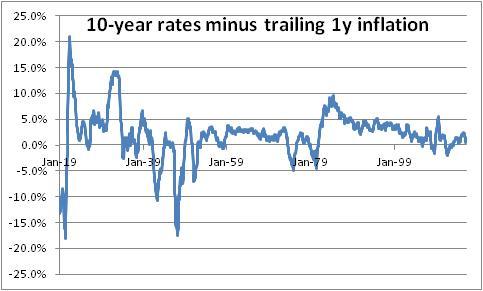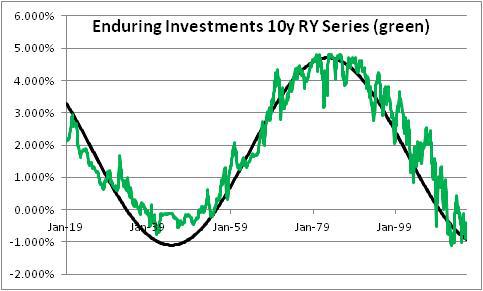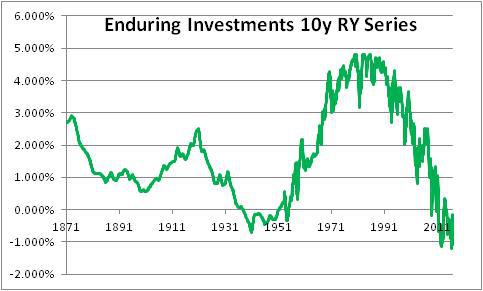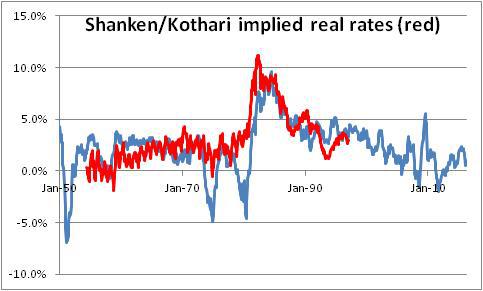One of the problems that inflation folks have is that the historical data series for many of the assets we use in our craft are fairly short, low-quality, or difficult to obtain. Anything in real estate is difficult: farmland, timber, commercial real estate. Even many commodities futures only go back to the early 1980s. But the really frustrating absence is the lack of a good history of real interest rates (interest rates on inflation-linked bonds). The UK has had inflation-linked bonds since the early 1980s, but the US didn’t launch TIPS until 1997 and most other issuers of ILBs started well after that.
This isn’t just a problem for asset-allocation studies, although it is that. The lack of a good history of real interest rates is problematic to economists and financial theoreticians as well. These practitioners have been forced to use sub-optimal “solutions” instead. One popular method of creating a past history of “real interest rates” is to use a nominal interest rate and adjust it by current inflation. This is obvious nonsense. A 10-year nominal interest rate consists of 10-year real interest rates and 10-year forward inflation expectations. The assumption – usually explicit in studies of this kind – is that “investors assume the next ten years of inflation will be the same as the most-recent year’s inflation.”
We now have plenty of data to prove that isn’t how expectations work – and, not to mention, a complete curve of real interest rates given by TIPS yields – but it is still a popular way for lazy economists to talk about real rates. Here is what the historical record looks like if you take 10-year Treasury rates and deflate them by trailing 1-year inflation:

This is ridiculously implausible volatility for 10-year real rates, and a range that is unreasonable. Sure, nominal rates were very high in the early 1980s, but 10%? And can it be that real rates – the cost of 10-year money, adjusted for forward inflation expectations – were -4.6% in 1980 and +9.6% in 1984? This hypothetical history is clearly so unlikely as to be useless.
In 2000, Jay Shanken and S.P. Kothari wrote a paper called “Asset Allocation with Conventional and Indexed Bonds.” To make this paper possible, they had to back-fill returns from hypothetical inflation-linked bonds. Their method was better than the method mentioned above, but still produced an unreasonably volatile stream. The chart below shows a series, in red, that is derived from their series of hypothetical annual real returns on 5-year inflation-indexed bonds, and backing into the real yields implied by those returns. I have narrowed the historical range to focus better on the range of dates in the Shanken/Kothari paper.
You can see the volatility of the real yield series is much more reasonable, but still produces a very high spike in the early 1980s.
The key to deriving a smarter real yield series lies in this spike in the early 1980s. We need to understand that what drives very high nominal yields, such as we had at that time in the world, is not real yields. Since the real yield is essentially the real cost of money it should not ever be much higher than real potential economic growth. Very high nominal yields are, rather, driven by high inflation expectations. If we look at the UK experience, we can see from bona fide inflation-linked bonds that in the early 1980s real yields were not 10%, but actually under 5% despite those very high nominal yields. Conversely, very low interest rates tend to be caused by very pessimistic real growth outcomes, while inflation expectations behave as if there is some kind of floor.
We at Enduring Investments developed some time ago a model that describes realistically how real yields evolve given nominal yields. We discovered that this model fits not only the UK experience, but every developed country that has inflation-linked bonds. Moreover, it accurately predicted how real yields would behave when nominal yields fell below 2% as they did in 2012…even though yields like that were entirely out-of-sample when we developed the model. I can’t describe the model in great detail because the method is proprietary and is used in some of our investment approaches. But here is a chart of the Enduring Investments real yield series, with the “classic” series in blue and the “Shanken/Kothari” series in red:

This series has a much more reasonable relationship to the interest rate cycle and to nominal interest rates specifically. Incidentally, when I sat down to write this article I hadn’t ever looked at our series calculated that far back before, and hadn’t noticed that it actually fits a sine curve very well. Here is the same series, with a sine wave overlaid. (The wave has a frequency of 38 years and an amplitude of 2.9% – I mention this for the cycle theorists.)

This briefly excited me, but I stress briefly. It’s interesting but merely coincidental. When we extend this back to 1871 (using Shiller data) there is still a cycle but the amplitude is different.

So what is the implication of this chart? There is nothing predictive here; about all that we can (reasonably) say is what we already knew: real yields are not just low, but historically low. (Current 10-year TIPS yields are higher than our model expects them to be, but not by as much as they were earlier this year thanks to a furious rally in breakevens.) Money is historically cheap – again, we knew this – in a way it hasn’t been since the War effort when nominal interest rates were fixed by the Fed even though wartime inflation caused expectations to rise.
With real yields that low, how did the war effort get funded? Who in the world lent money at negative real interest rates like banks awash in cash do today? That’s right…patriots.
Frankly, that makes a lot more sense than the reason we have low real interest rates today!

